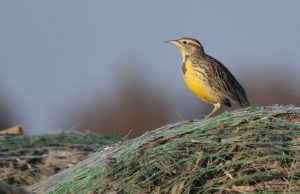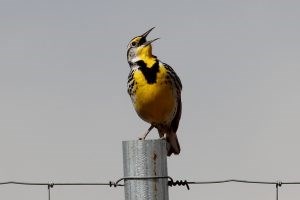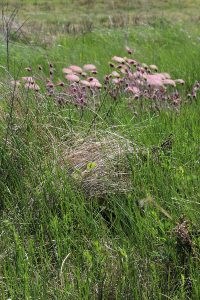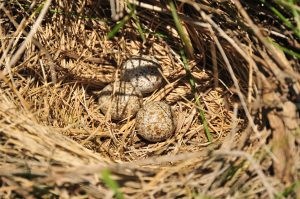This content was originally published by the Longmont Observer and is licensed under a Creative Commons license.
One of my favorite sights this time of year is of a male western meadowlark sitting on top of a fence post, head thrown back, singing for all he’s worth. I love listening to the melodic songs. Despite its name, the western meadowlark isn’t related to larks at all, but to blackbirds.
The explorers Lewis and Clark knew about the meadowlark. Meriwether Lewis was the first to point out that the eastern and western meadowlarks were actually different species. Because John James Audubon felt the meadowlark was often overlooked, he gave it the scientific name Sturnella neglecta, Sturnella referring to a “starling-like” bird. At the edges of their territory, the eastern and western meadowlarks do not interbreed. Apparently, the two species can recognize each other by their differing songs.
The western meadowlark is similar in size to a robin but has a shorter tail and a flat head with a long slender bill. They range in size between six and ten inches long and weigh between three and four ounces.
The back and sides of the meadowlark are a patterned color that includes brown, black, and buff. The chest of the bird is a bright yellow color that is crossed by a black “V” shape. During the winter, the yellow chest and black “V” are paler in color. The head has contrasting stripes of dark brown and light buff. During flight the outer edges of the tail appear white.

Western meadowlarks inhabit open grasslands, prairies, meadows, and fallow agricultural fields. They avoid areas with wooded edges or lots of shrubs.
Western meadowlarks feed on grains, weed seeds, and insects, and their food preferences show seasonal variation. In the winter, food is primarily comprised of grains and in the fall, food is primarily made up of weed seeds. Insects comprise the majority of the diet during the spring and summer.
Western meadowlarks use a feeding method called “gaping” in which they insert their bill into the soil or other substrate and pry it open. This allows them to reach insects and seeds that other birds can’t access. Western meadowlarks have been known to eat the eggs of other grassland bird species. In particularly harsh winters, they may also eat roadkill or other carcasses.
Male western meadowlarks arrive two to four weeks before the females to stake out and claim their territory. Males defend their territory aggressively using “pursuit flights’ that may last up to three minutes. In addition, a “jump flight” may be performed in which the male flies straight up into the air several feet and basically hovers by fluttering their wings and allowing their feet to hang limp. Males also sing to defend their territory and to advertise their presence to other males and to the arriving females.

Once the female arrives on a male’s territory that she has chosen, she may initiate an aerial chase. When the male and female land, the male performs his courtship display. Male western meadowlarks court females by facing the female, puffing out the chest and pointing the bill straight upwards to show off the black “V” on the chest. At the same time they will spread their tail feathers and flick their wings.
Western meadowlarks are polygynous and males typically have two mates at a time. The pair bond between the male and female lasts for one breeding season. Breeding occurs between March and August.
The female western meadowlark chooses the nest site. The nest is typically built in a depression on the ground, such as a livestock footprint, and is surrounded by dense vegetation. This makes the nest difficult to see.
The female also builds the nest by herself. The depression is shaped into a cup-like shape and lined with soft dry grass and shrub stems. Often, the surrounding vegetation is woven into a hood-like dome over the nest that is waterproof. The finished nest is seven to eight inches in diameter, with the cup itself being four to five inches in diameter and two to three inches deep. It takes the female about a week to build the nest. Short “runways” into the surrounding vegetation are created by the movement of the parents to and from the nest.
Females lay between three and seven eggs, with the average being five. Eggs are white and heavily spotted with brown and purple, particularly at the large end of the egg. The female incubates the eggs by herself for 13-15 days. Western meadowlarks are very sensitive to disturbances and will readily abandon the nest if they are disturbed during incubation. Females typically build a second nest and lay a second clutch once the young have left the nest.

The young are born naked and helpless (altricial). The female broods the young and feeds them. Males will often carry food to the nest, but rarely deliver food to the nestlings themselves. Insects make up most of the food fed to nestlings. The young leave the nest about 12 days after hatching, but they are not yet able to fly. The parents will tend to the nestlings for another two weeks.
The population of western meadowlarks has been gradually declining. One factor in the decline is the conversion of agricultural land and grasslands to housing and urban areas. Other factors that may play a role include pesticide use, fire suppression (which alters native grasslands), and invasive plant species.
The song of the western meadowlark is flutelike and complex. Males have a two-phrase song that begins with one to six pure whistles followed by a series of one to five gurgling warbles. Males can have up to a dozen different songs. The most common song sung by western meadowlarks is a low chupp or pluk which is given during courtship and territorial displays and when disturbed. The female gives a soft rattle during courtship and a low tee-tee-tee during nest building and egg laying.

Although you are unlikely to find meadowlarks in the middle of Longmont, you can easily find them in the open areas surrounding town. I often see at least one pair on County Line Road just after turning south from 17th. If you go to Sandstone Ranch off of 119, you will likely hear them singing. Their song is a real treat to hear, so take some time to get out into nature and look (or listen) for this bird.


